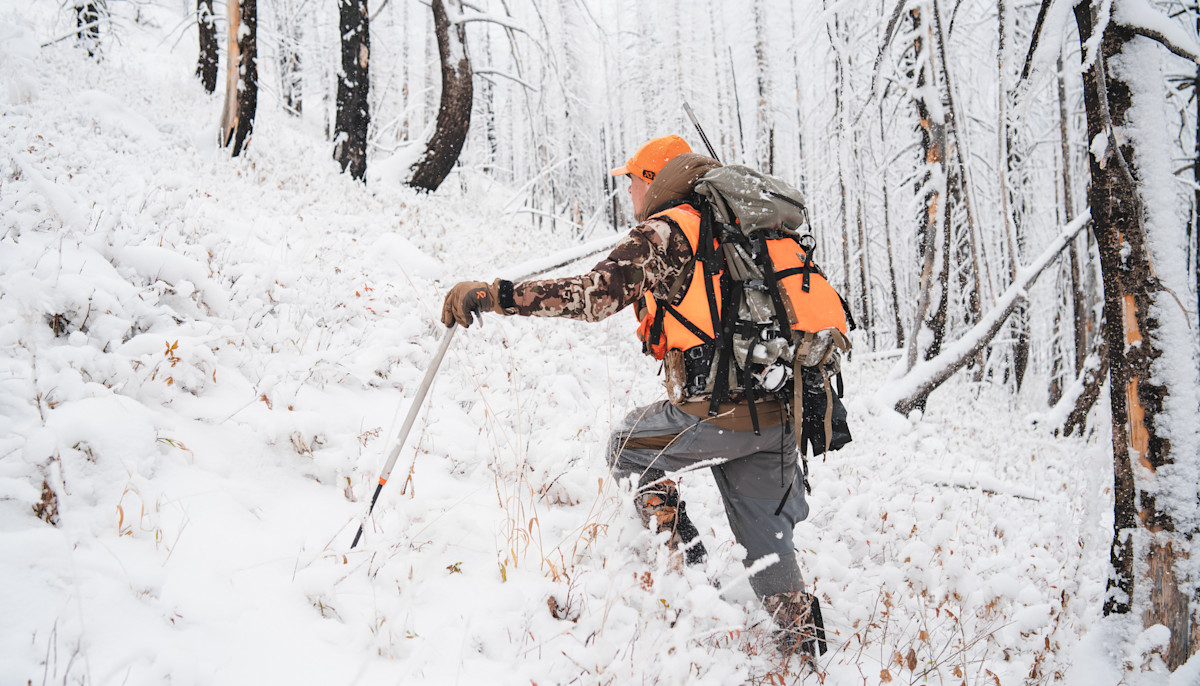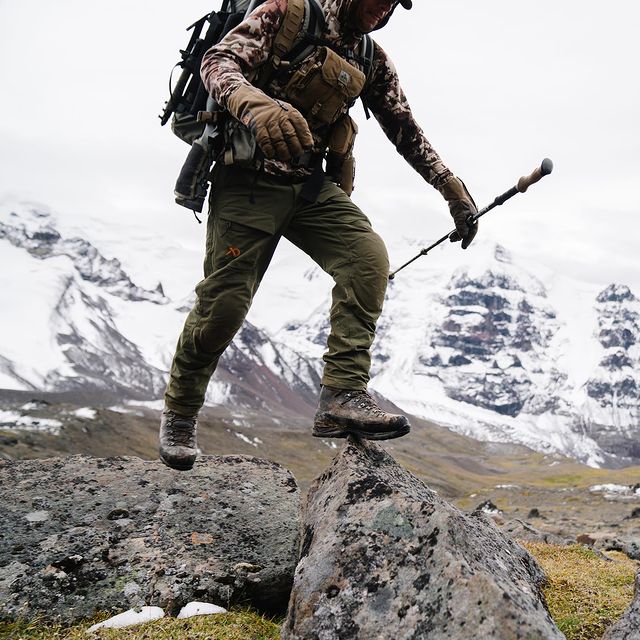
More than any other single item of gear, your pants will make or break a hunting trip. If they’re too tight or too baggy, you can’t walk right. Too thin and you’re cold; no ventilation and you’re hot. A lot of hunters struggle for years to find the best hunting pants for their body shape and hunting habitat. In this article, we'll go through the factors we consider when choosing a hunting pant, and the pants that hit high marks on those factors.
Jump to: Hunting Pants We Use
What We Look For In Good Hunting Pants
Every experienced hunter has their own set of parameters for covering their legs from the elements. The criteria we focus on are:
- Durability
- Versatility
- Weight
- Fit
We want pants that we almost forget are there; pants that don’t impede movement, don’t tear, don’t make us chilly or overheated, and have pockets where you’d naturally reach. You don’t want this element of your kit to be what sends you back to the truck early.
Jump to: What Makes A Good Hunting Pant
Hunting Pants We Use
Our crew spends a lot of time in the field and the pants we've included here are the ones that we use most. There are plenty of other options like puffy pants for long glassing sessions, brush pants for upland hunts, insulated bibs for tree sits and a collection of women's hunting pants. Keep the criteria above in mind; we think they will help you choose the best hunting pants for your next hunt.
 First Lite Corrugate Foundry
Steve's Pick
|
 First Lite Obsidian Foundry
Cal's Pick
|
 First Lite Catalyst Foundry
Brody's Pick
|
 First Lite Omen Stormshelter Pant
Sam's Pick
|
|
|---|---|---|---|---|
| Best For | All Seasons | Warm Weather | Cold Weather | Rain |
| Temps | 15° to 80° F | 25° to 100° F | -20° to 50° F | 20° to 60° F |
| Weight | 28 oz | 21 oz | 35 oz | 30.25 oz |
| Kneepads | Yes | No | Yes | Yes |
| Side Zips | Upper Leg | None | Full | Full |
| Waterproofing | DWR+ * | DWR | DWR+ * | 4.5-Layer |
| Price | $200 | $195 | $250 | $390 |
| Field Notes | Field Notes | Field Notes | Field Notes |
What Makes a Good Hunting Pant
Here's a detailed breakdown of the criteria we use to choose the best hunting pants. There are more things to think about for specific pursuits and conditions, but for us, these four criteria apply across the board.
1. Durability
Barbed wire, sharp sticks, broken rock, briars, and cacti all conspire to shred fabrics that aren’t up to snuff. Standard hiking pants and low-end hunting models may function for a while, but they’re likely to fail right when you need them most—ripping out the knee on a belly-crawl stalk toward a bedded buck or unstitching the crotch as you chase a bugling bull through deadfall timber. It’s important to have serious materials in those failure points so you can stay focused on the moment of truth.
2. Versatility
Hunt long enough and you won’t be fooled by the current conditions or even the weather forecast. Far too many weekends have started sunny and wound up snowy, or the reverse. Do you want to carry three pairs of pants in your backpack? Probably better to just wear one pair that can adapt to whatever weather you might encounter. We look for pants that breathe well but still insulate, whether that’s through high-end materials or well-placed, zippered vents. Side zips let you lock in body heat when you’re not moving and dump it out when you are. Many pants can also be worn from early season to late by adding baselayers underneath, dramatically increasing versatility.
3. Weight
It's easy to stay warm in thick wool pants that weigh ten pounds. It’s easy to stay cool in thin nylon hiking pants. But neither will serve you particularly well for any normal day of real hunting. Rather, we’d prefer warmth without the weight or coolness without the discomfort. Because they’re on your legs, your pants have an outsized effect on your exertion as you hike. Weight does come with insulation, but it can be kept to a minimum. By the same token, durability and low weight are not mutually exclusive.
4. Fit
Finally, and obviously, you need a pair of pants that fit. But that can be surprisingly hard to achieve when the offerings only come in small, medium, and large. Leg and hip sizes vary widely among us hunters, so only you will know which pants allow those hiking muscles to swing freely. Pants offered in a variety of waist and length measurements help the discerning hunter dial in their fit. Ergonomic construction aids your athletic ability as well, whether that’s used for climbing trees or climbing mountains.
Thoughts on Waterproofness and Water Resistance
Have you ever tried running in a raincoat? What about in fishing waders? If not, allow me to save you the suspense: you get a personal sauna going really fast.
Waterproofness and breathability pull in opposite directions when it comes to garment design. While some modern, high-tech fabrics strike a surprisingly good balance, you don’t really want to wear fully waterproof clothes unless it’s actually wet out. Most of the time when you’re hunting in relatively dry conditions, you’ll want to lean more toward venting your body heat and staying quieter than most rainwear will allow. Water-resistant DWR finishes will still shed water from wet brush and such while allowing ventilation. Most of us carry rainpants in our packs to throw on over our hunting pants in case of actual precipitation.
Still, rain, snow, and frost moisture can linger for a long time in the soil even when the ambient air and vegetation have largely dried out. That’s why it’s nice to have strategic waterproofness in the knees and seat of quality hunting pants. These panels will still let the garment breathe but won’t leave you with a wet, chilly butt after a glassing session.
Field notes from the MeatEater Crew
We could talk for hours about each piece of gear in our kits, and we know a lot of you love the details. We've summarized the key specs below along with comments from the crew.
Steve's Pick
All Seasons
In our view, the First Lite Corrugate Foundry is the hunting pant perfected. The bomb-proof, tear-proof, waterproof knees and seat mean you never have to worry about rips or going to the ground when you need to, while the side zips don’t let you get too sweaty or too shivery. The ergonomic shape and stretchy, water-resistant soft shell just make you feel like hiking. The pockets are situated for easy access to electronics and gear without hindering movement, and the removable kneepads make belly-crawling a breeze. Most of the MeatEater crew has been living in these things during hunting season. MeatEater founder Steven Rinella takes that praise a few steps further:
“Someday I’m gonna make a museum of the world’s greatest hunting gear and I’m gonna put First Lite’s Corrugate Foundry Pants near the entrance. These are the most comfortable, durable, versatile hunting pants to ever hit the market. I’m dead serious, if I could only have one of pair of pants for the rest of my life, these would be it.”
Specifications
- Material: Full-stretch Guide Nylon with DWR treatment. Chap Nylon reinforced knees and seat.
- Primary Use: Western big game, whitetail, upland, fishing
- Weight: 28 oz.
- Temp Range: 15° to 80° F
- Fit: Athletic, Numeric sizing
Cal's Pick
Warm Weather
There was a time when the phrase “hunting pants” was almost synonymous with wool. This natural fiber breathes, stays warm even when it’s wet, and, most of all, it’s really, really quiet. Those merits only improved with the advent of lighter, thinner Merino wool. MeatEater's Ryan Callaghan says the properties of Merino in the Obsidian Pant provide all he needs for the majority of his mountain mule deer or elk hunting seasons in the West, without too many frills:
“I don't need a lot of stretch and I don't treat these pants like a pair of chainsaw chaps. The Obsidians are not a one-pant-does-all brush buster, they are not waterproof, and they don't have vents, but they are a solution for staying comfortable throughout a huge temperature range. I'm able to wear them from August through December and leave the thick baselayer bottoms in the closet until only the bitter cold days of the season. Combine these with a pair of puffy pants and you'll be able to laugh comfortably at the kids with the zip-off underpants who think they found a way around learning how to dress.”
Specifications
- Material: Midweight Ripstop Merino Wool with full-stretch Guide Nylon in critical zones for range of motion and durability.
- Primary Use: Western big game, whitetail, upland
- Weight: 21 oz.
- Temp Range: 25° to 100° F
- Fit: Athletic, Numeric sizing
Brody's Pick
Cold Weather
For those bitter-cold days of the season, when snow blankets the world and the mercury drops like a head-shot teal, you want your pants to keep pace. A little insulation goes a long way, and the Catalyst Foundry Pant nails the balance between warmth, weight, breathability, and mobility. MeatEater's Brody Henderson reports:
“I just got back from a 10-day trip into the Missouri River Breaks and I wore the Catalyst Foundry Pants every day of that hunt. They're warm, tough, breathable, and despite their burly construction, you can hike in rough country comfortably all day long. The knee pads might seem like overkill for most hunting situations, but you can easily slide them out and stuff them in your pack until you're crawling through rocks and cactus to get into shooting range. They’re by far the best mid- to late-season pants I've ever worn.”
Specifications
- Material: Polyester face with 37.5-treated fleece backer. Chap Nylon reinforced knees and seat.
- Primary Use: Western big game, whitetail, upland, waterfowl, fishing
- Weight: 35 oz.
- Temp Range: -20° to 50° F
- Fit: Athletic, Numeric sizing
Sam's Pick
Rain
As I mentioned earlier, oftentimes you don’t want fully waterproof pants for a normal day of hunting. But sometimes you really, really do.
We frequently travel to places like Southeast Alaska or Western Montana or Northern Michigan in times like April and November, when precipitation is more of an expectation than a possibility. For those times, we always want to have a great pair of waterproof pants squirrelled away in our packs for when the clouds suddenly go dark.
The Omen Stormshelter Pant provides that protection while still allowing the freedom of movement and breathability to hike from the tidewater to the alpine—or wherever else you may encounter nasty weather. Wear these over a warm baselayer and Foundry pant and you can maintain the body heat and dryness it takes to sit out a November squall in the whitetail stand or the goose blind. Fill the giant dump pockets with gloves, calls, or shells. The full-length side-zip allows you to don them quickly as the storm shows up without removing your boots, integrating this shell with your hunting pants and providing ventilation and easy access to your pockets. Best of all, they're so light and compactable that you almost forget they're in your backpack until you need them.
Specifications
- Material: 4.5-layer Rain Shell with 37.5 active particle technology printed internally to remove moisture.
- Primary Use: Rain protection, Western big game, whitetail, waterfowl, fishing
- Weight: 30.25 oz.
- Temp Range: 20° to 60° F
- Fit: Oversized to wear over hunting pants and insulating layers, Alpha sizing








